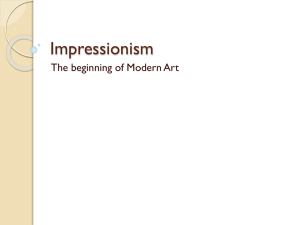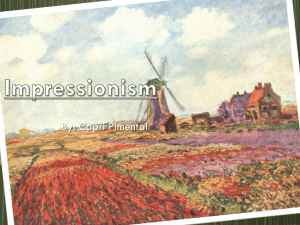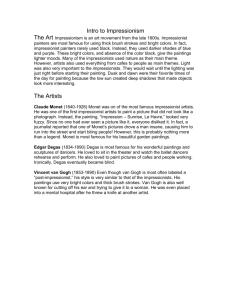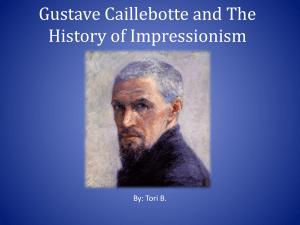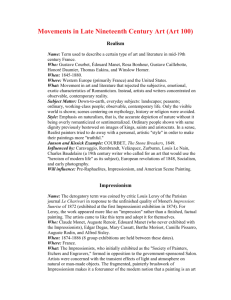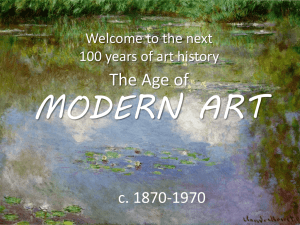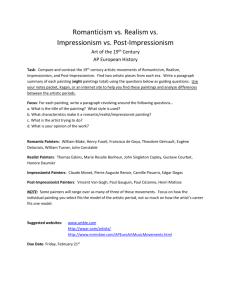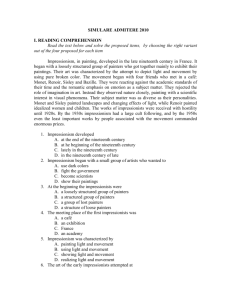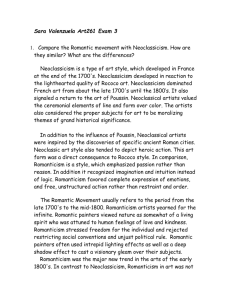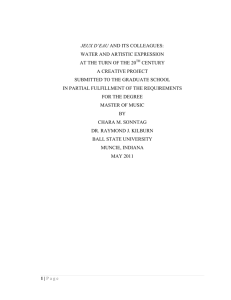Student Example 10 research
advertisement
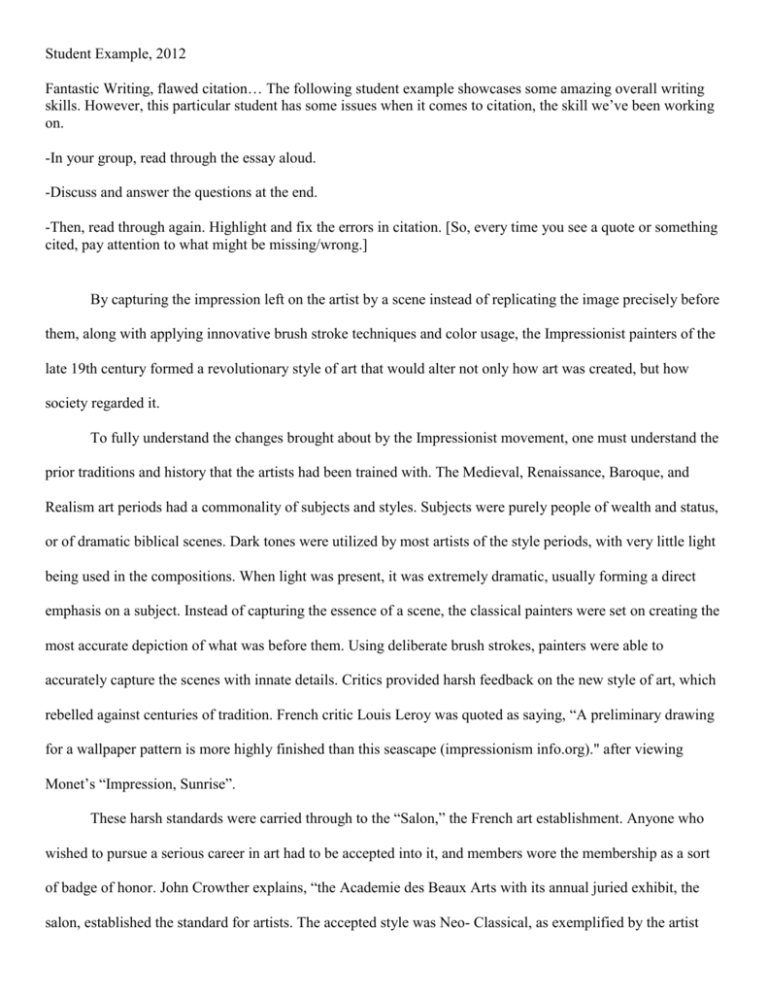
Student Example, 2012 Fantastic Writing, flawed citation… The following student example showcases some amazing overall writing skills. However, this particular student has some issues when it comes to citation, the skill we’ve been working on. -In your group, read through the essay aloud. -Discuss and answer the questions at the end. -Then, read through again. Highlight and fix the errors in citation. [So, every time you see a quote or something cited, pay attention to what might be missing/wrong.] By capturing the impression left on the artist by a scene instead of replicating the image precisely before them, along with applying innovative brush stroke techniques and color usage, the Impressionist painters of the late 19th century formed a revolutionary style of art that would alter not only how art was created, but how society regarded it. To fully understand the changes brought about by the Impressionist movement, one must understand the prior traditions and history that the artists had been trained with. The Medieval, Renaissance, Baroque, and Realism art periods had a commonality of subjects and styles. Subjects were purely people of wealth and status, or of dramatic biblical scenes. Dark tones were utilized by most artists of the style periods, with very little light being used in the compositions. When light was present, it was extremely dramatic, usually forming a direct emphasis on a subject. Instead of capturing the essence of a scene, the classical painters were set on creating the most accurate depiction of what was before them. Using deliberate brush strokes, painters were able to accurately capture the scenes with innate details. Critics provided harsh feedback on the new style of art, which rebelled against centuries of tradition. French critic Louis Leroy was quoted as saying, “A preliminary drawing for a wallpaper pattern is more highly finished than this seascape (impressionism info.org)." after viewing Monet’s “Impression, Sunrise”. These harsh standards were carried through to the “Salon,” the French art establishment. Anyone who wished to pursue a serious career in art had to be accepted into it, and members wore the membership as a sort of badge of honor. John Crowther explains, “the Academie des Beaux Arts with its annual juried exhibit, the salon, established the standard for artists. The accepted style was Neo- Classical, as exemplified by the artist Jean Jacques David.” But even more regulated was the subject matter. “Subject matter was to be based primarily on historical events, mythology, and religion. Man was to be presented as an ideal, nature was to be celebrated and romanticized. It was realistic, but not realism as we see it and experience in our everyday lives. Rather it was realism as imagined through the prism of a quest for classical perfection (Crowther).” In contrast, the Impressionistic painters chose much simpler subject material. Instead of dramatic biblical scenes or imposing portraits of aristocrats, they put a stronger emphasis on reality instead of what was beyond what they could experience. “Unlike conservative painters who focused on portraying dramatic, often historical scenes of idealized beauty and moral or religious meaning, the Impressionists chose ordinary scenes from everyday life as the subject matter of their work.” For the first time, ordinary people were captured during everyday life. Scenes of cafes, streets, and chores were found in multiple paintings throughout this era, tracing the daily life of common people. “They saw the beauty of the world as a gift and the forces of nature as aids to human progress (Preble).” Nature scenes were painted often, but again, instead of capturing the exact image, the essence of the world around them was created. Pierre-Auguste Renoir once said, "if the painter works directly from nature, he ultimately looks for nothing but momentary effects; he does not try to compose, and soon he gets monotonous.” But perhaps the most socially disturbing were the nude scenes. Previously, nudes were used in biblical scenes to convey a certain idea. But the Impressionist painters used these images in a completely new way. Nude women could be seen conversing with men at a garden party, or dancing around a ball room. This point blank rebellion caused a stir within the art world of the Salon, or the French art institution. A second distinctive quality of the era was that the Impressionists left much to the audiences imagination. Using quick, broken, brushstrokes, lines blended together, leaving a blurred image. The Impressionists were fixated on creating a sense of movement, such as what can be caught through a moving camera lens. “In their attempts to capture a given moment, they omitted detail in favor of the overall effect of the painting (impressionism info.com).” Softened lines and blended edges created a dreamlike picture. In some cases, the compositions became so blurred that it became impossible for the viewers to understand what the subject before them was. “In turning away from the fine finish and detail to which most artists of their day aspired, the Impressionists aimed to capture the immediate effect of a scene - the impression it made on the eye in a fleeting instant (Justin Wolf).” One of the most renowned Impressionist painters, Claude Monet was known especially for his blurred lines through using a wet-on-wet technique. “He did not wait for paint to dry before applying successive layers, and this 'wet on wet' technique produced softer edges and blurred boundaries which merely suggested a three-dimensional plane, rather than depicting it realistically (Justin Wolf).” Color usage is the final distinctive quality of the Impressionist era. Edouard Manet was once quoted as saying "there are no lines in nature, only areas of color, one against another." Bright colors were utilized in every aspect, from direct subject material to the shadows that resulted from it. Splashes of color were used in place of whites, blacks, and greys when dealing with light and dark. Margaret Samu explains, “the nineteenth century saw the development of synthetic pigments for artists' paints, providing vibrant shades of blue, green, and yellow that painters had never used before.” Along with the newly developed materials, independent artists were choosing to forgo the traditional golden varnish that usually muted the finished product. Because of the varnish not being used, colors remained vibrant and bright. All of these factors contributed to modern art, as we know it today. Without these innovative men and women, the world would have radically different and much stricter views on what constitutes the term “art.” Opening doors to new subject material and styles, the art world was broadened by a group of strong personalities and creative minds. Works Cited "The Beginning of Impressionist Art..." Oil Painting Reproductions of Impressionist Masterpieces. Impressionist Art Gallery, 2004. Web. 25 Mar. 2012. <http://www.impressionist-artgallery.com/impressionist_art.html>. Crowther, John. "Article - Impressionism." Artist Perspectives. Artist Perspectives, 2005. Web. 27 Mar. 2012. <http://www.artist-perspectives.com/articles/impressionism.htm>. "History of Art:The Impressionism - Camille Pissarro." History of Art. Web. 28 Mar. 2012. <http://www.allart.org/history480.html>. "Impressionist Art Movement Information about Impressionism Paintings - Still Life Landscapes Nature Paris." French Impressionism Art Posters Prints Museums Art Books Calendars Impressionist Artists Claude Monet Edgas Degas Manet Cezanne Renoir. Impressionism.info, 2005. Web. 25 Mar. 2012. <http://www.impressionism.info/info.html>. Wolf, Justin. "The Art Story: Impressionism Movement." The Art Story: Modern Art Movements, Artists, Ideas and Topics. The Art Story Foundation, 2012. Web. 26 Mar. 2012. <http://www.theartstory.org/movement-impressionism.htm>. "Impressionism." Error. Lynn University Art Appreciation. Web. 02 Apr. 2012. <http://www.cartage.org.lb/en/themes/Arts/painting/modernity/impression/impression.htm>. Samu, Margaret. Heilbrunn Timeline of Art History. Impressionism: Art and Modernity. Met Museum, 2004. Web. 02 Apr. 2012. <http://www.metmuseum.org/toah/hd/imml/hd_imml.htm>. Weinberg, Barbara H. Heilbrunn Timeline of Art History. American Impressionism. Met Museum. Web. 05 Apr. 2012. <http://www.metmuseum.org/toah/hd/aimp/hd_aimp.htm>. Pool, Phoebe. Impressionism. New York: Praeger, 1967. Print. Brettell, Richard R. Modern Art, 1851-1929: Capitalism and Representation. Oxford: Oxford UP, 1999. Print. Questions to respond to: What did this student do right in her introduction? What did this student do right as far as organization of her writing? Do you feel that the balance between the student’s own voice and her information is good? Does it sway to one side or the other? Explain your answer. How does this student make her research essay into a focused message, rather than just random information? What is her message? What do you think this student’s inquiry question might have been? Now, fix her citations!
